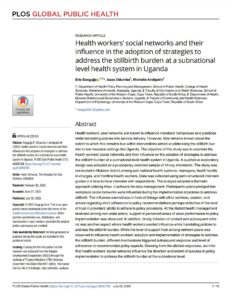
Abstract
Health workers’ peer networks are known to influence members’ behaviours and practices while translating policies into service delivery. However, little remains known about the extent to which this remains true within interventions aimed at addressing the stillbirth burden in low-resource settings like Uganda. The objective of this study was to examine the health workers’ social networks and their influence on the adoption of strategies to address the stillbirth burden at a subnational level health system in Uganda. A qualitative exploratory design was adopted on a purposively selected sample of 16 key informants. The study was conducted in Mukono district among sub-national health systems, managers, health facility in-charges, and frontline health workers. Data was collected using semi-structured interview guides in a face-to-face interview with respondents. The analysis adopted a thematic approach utilising Atlas. ti software for data management. Participants acknowledged that workplace social networks were influential during the implementation of policies to address stillbirth. The influence exerted was in form of linkage with other services, caution, and advice regarding strict adherence to policy recommendations perhaps reflective of the level of trust in providers’ ability to adhere to policy provisions. At the district health management level and among non-state actors, support in perceived areas of weak performance in policy implementation was observed. In addition, timely initiation of contact and subsequent referral was another aspect where health workers exerted influence while translating policies to address the stillbirth burden. While the level of support from among network peers was observed to influence health workers’ adoption and implementation of strategies to address the stillbirth burden, different mechanisms triggered subsequent response and level of adherence to recommended policy aspects. Drawing from the elicited responses, we infer that health workers’ social networks influence the direction and extent of success in policy implementation to address the stillbirth burden at the subnational level.
Study Design
The study adopted a qualitative exploratory design. We aimed to understand the influence of health worker social networks in addressing the stillbirth burden. Subnational health systems adopted policy priorities highlighted at the national level in a bid to address stillbirth in Uganda after global campaigns guided national level efforts which gained momentum after 2011.
Discussion
Our results suggest that health workers’ social networks influence the adoption of strategies to address the stillbirth burden at a subnational level health system in Uganda. We found evidence that health workers implementing maternal and child health policies at the subnational level worked within a social system that constituted an interwoven network. As such, through their supervision interactions and workplace relationships, these networks emerged among peers. These to a great extent influenced how health workers translated policies to address the stillbirth burden. Workplace networks had the greatest influence which was perhaps reflective of the importance of implementation context in directing policy outcomes. From the different levels of service delivery, the influence was more of linkage to other services not available at the point of care which may be reflective of limited resource context. It also reflected the hierarchical supervision relationships which were interwoven in the routine delivery of maternal health services at the subnational level. Among the private-for-profit providers, the influence was in form of caution and advice to stick to strict policy implementation expectations which may perhaps be reflective of the levels of trust in the ability of these actors to comply with policy provisions.
Read more about stillbirths here.